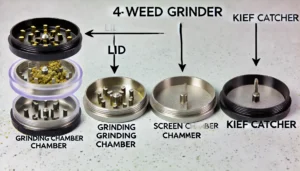Weed Seed Bank: What It Is and How to Manage It Effectively
Understanding the Weed Seed Bank
The weed seed bank is the accumulation of viable weed seeds in the soil, originating from previous growing seasons. These seeds, along with vegetative propagules such as rhizomes and tubers, determine future weed infestations. Agricultural soils can contain thousands of weed seeds per square foot, with their density varying based on farming practices and environmental conditions.
Managing the weed seed bank is a long-term strategy to reduce weed pressure in crops. A well-controlled seed bank can significantly lower weed emergence, minimizing competition with crops and reducing the need for herbicides or manual weeding.
How Weed Seeds Enter and Persist in the Soil
Sources of Weed Seeds in the Seed Bank:
- Seed rain – weeds shedding seeds into the soil.
- Vegetative propagation – perennial weeds spreading through rhizomes and tubers.
- External contamination – seeds brought in via wind, water, animals, manure, machinery, or farm inputs like mulch.
Once deposited, weed seeds can remain dormant for years, surviving adverse conditions until favorable germination factors arise. Factors affecting seed longevity include soil depth, disturbance, microbial activity, and predation by insects, birds, and rodents.
How to Reduce the Weed Seed Bank
Minimizing weed seeds in the soil requires a two-step approach: preventing new deposits and accelerating seed depletion.
1. Reduce New Weed Seeds (“Deposits”)
- Prevent weeds from reaching maturity – early removal stops them from producing seeds.
- Use cover crops – suppress weed growth and reduce seed production.
- Practice crop rotation – disrupts weed life cycles and prevents species dominance.
- Control field margins – prevent weed encroachment from surrounding areas.
2. Maximize Weed Seed Depletion (“Withdrawals”)
- Encourage germination at the wrong time – tilling before planting triggers weed emergence, allowing early elimination.
- Use stale seedbed techniques – prepare the soil, allow weeds to sprout, then remove them before planting.
- Foster seed predation – maintain a habitat for weed seed predators like beetles and rodents.
- Apply targeted tillage – shallow tillage can expose seeds to environmental decay while deep tillage buries short-lived seeds beyond their emergence depth.
Weed Seed Bank Dynamics: How Long Do Seeds Last?
The lifespan of weed seeds varies significantly:
- Short-lived seeds (1–3 years): foxtail species, hairy galinsoga.
- Moderate lifespan seeds (3–10 years): pigweed, lambsquarters.
- Long-lived seeds (10+ years): velvetleaf, morning glory, curly dock.
Research shows that consistent weed control for five years can reduce seed banks by over 90%, but allowing weeds to mature for even one season can quickly restore seed levels.
Best Practices for Long-Term Weed Seed Bank Management
- Tillage timing: Perform shallow cultivation before planting to stimulate and eliminate weed germination.
- Precision planting: Optimize crop spacing and canopy cover to outcompete weeds.
- Weed monitoring: Conduct soil tests or controlled germination tests to assess seed bank density and species composition.
- Integrated weed management: Combine mechanical, biological, and cultural control methods to maintain low weed populations.
By implementing these strategies, farmers and growers can significantly reduce the persistence of weeds, lower production costs, and improve overall crop health.
Key Takeaway:
Managing the weed seed bank is a long-term investment in sustainable weed control. By preventing seed accumulation and accelerating depletion, growers can maintain cleaner fields and minimize future weed problems.
Next Steps:
Want to learn more about weed management strategies? Explore advanced cultivation techniques and integrated weed control methods to keep your fields weed-free.













